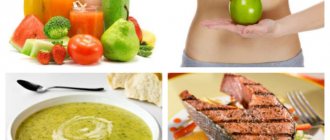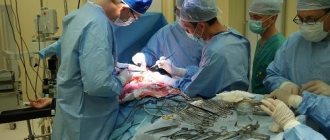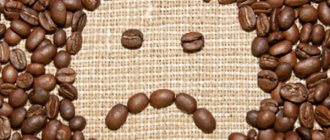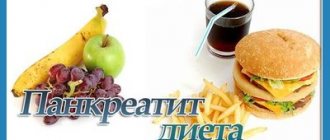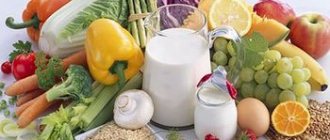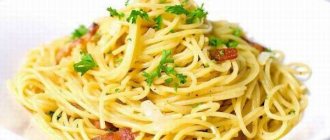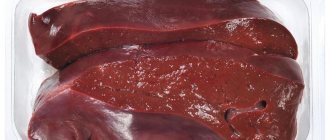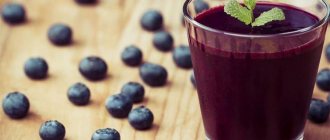When an enlarged pancreas occurs in a child, the diet must be strictly followed without fail.
Only it can improve the patient’s condition, improve the functioning of the pancreas, and relieve pain. Even a slight increase in the size of the pancreas is a serious cause for concern.
When this disease is first detected, all measures must be taken to eliminate it.
General information about the disease
Pancreatitis is an inflammation of the pancreas, more precisely its tissues and ducts. In children, this disease is often disguised as other pathologies of the gastrointestinal tract: gastritis, gastroduodenitis, dysbacteriosis. Sometimes it occurs with symptoms that are not clearly expressed.
Without treatment, the disease can become chronic and cause complications. Therefore, an urgent task in pediatrics and gastroenterology is to identify pathology at an early stage of the disease, which can be treated.
Symptoms
Pancreatitis in children is mild in most cases. Severe forms of the disease, for example, purulent-necrotizing pancreatitis, are very rare. At the same time, the severity of symptoms is extremely weak.
Manifestations of pathology depend on the form of the disease. Acute pancreatitis is characterized by pain in the epigastric region, which radiates to the back and right hypochondrium. In addition, children experience dyspeptic disorders: nausea, vomiting, flatulence, diarrhea, loss of appetite. Parents should be alert to pale skin, elevated body temperature, and a white coating on the tongue.
The symptoms of chronic pancreatitis in a child largely depend on the degree of the disease, its form and its duration. The patient is bothered by aching pain that occurs periodically. As a rule, they recur with errors in nutrition, stress, or significant physical activity. Attacks can last for several days and are accompanied by nausea, heartburn, constipation and diarrhea. Children experience increased fatigue during this period.
Recipes
We offer you several recipes for dishes that can be prepared with diagnosed pancreatitis.
Beef pudding
Grind the boiled beef pulp (130 g) in a blender bowl. Add semolina (10 g), beaten egg white, yolk and a little water (about 1/3 cup) to the puree. Add a few salt crystals. Grease the mold with oil, lay out the prepared minced meat and cook in a double boiler.
Fish quenelles
Grind lean fish (300 g) in a meat grinder. Grind a quarter of the dried loaf and pour milk (100 ml) into the pieces. Squeeze out the bread and mix it with the minced meat, add a couple of beaten egg whites. Add salt and mix thoroughly. Using two spoons, form small balls and boil them in salted water until tender. This will take approximately 15 minutes.
Vegetable puree soup
Boil potatoes (2 pieces), carrots and half a small zucchini until fully cooked. Pour the broth into a separate bowl and puree the vegetables using a blender. Pour broth into the puree to the desired consistency and bring to a boil. Cook for 3 minutes. Serve warm, adding a spoonful of sour cream to the soup.
Fish pudding
The fish carcass must be divided into two fillets. Boil the first and rub through a sieve. Grind the second part in a meat grinder. Combine both masses, add egg yolks, butter, salt. Knead. Divide into portioned molds and steam.
Chicken soufflé
Grind the boiled chicken meat in a meat grinder. Add egg yolks and butter to the minced meat. Mix the mass thoroughly. Then carefully add the whipped whites into a fluffy foam. Pour the mixture into a mold and steam.
Banana dessert
Dissolve 2 packs of gelatin according to the instructions. Add 250 ml of natural yogurt from it. Steam some bananas and peeled peaches. Place foil on the bottom of a plastic pan. Form the dessert in layers - biscuit crumbs, yogurt cream with gelatin, banana-peach puree. Alternate layers. Place the sweet in the refrigerator for the jelly to harden.
Compliance with the principles of dietary nutrition for pancreatitis is a prerequisite for achieving stable and long-term remission. The menu for patients with pancreatitis in adults and children, with the proper approach to development, can be quite varied and fully satisfy all the needs of the body.
Causes of pathology
The development of pancreatitis in children is due to the pathological influence of any factors on the pancreas. More often these are their own enzymes that damage organ tissue. This provokes the development of the inflammatory process. At the same time, tissue breakdown products are released into the bloodstream and lymph, which are very toxic, so intoxication of the body is very likely. The chronic inflammatory process is of a secondary nature, most often a consequence of previously suffered acute pancreatitis.
The main reasons for the development of the disease include external and internal factors:
- congenital and acquired anomalies of the digestive tract;
- benign and malignant neoplasms of the pancreas;
- endocrine system disorders;
- hormonal disorders;
- abdominal wall injuries;
- severe allergic reactions;
- concomitant gastrointestinal diseases;
- previous infectious diseases;
- helminthic infestations;
- long-term uncontrolled use of medications.
Recently, dietary errors have become a common cause of pancreatitis in children. If a child regularly eats spicy, fried, fatty foods, overeats, or prefers fast food to healthy foods, then disturbances in the digestive tract will not take long to occur.
General rules
The pancreas (PG) is the most important secretory organ of the child’s body, combining exocrine function (secretion of digestive enzymes involved in the digestion process) and endocrine (production of the most important hormones - insulin , lipocoine and glucagon , which control blood sugar levels).
The size of the pancreas in children normally depends on age: from 3 cm in newborns, 5.5 cm per year and about 8 cm by 10 years of age. The gland reaches its full size by the time of puberty. However, in some cases, when examining a child (ultrasound, computed tomography), an enlargement of the pancreas is noted. In this case, total enlargement is distinguished, in which all parts of the gland are uniformly/proportionally increased in size, and local, in which only one of the parts of the gland is enlarged (head, body or tail). The issue of enlarging the pancreas in a child must be approached very carefully, since during the growth process it increases several times in comparison with its original size and, at the same time, its growth at different age periods is not always uniform. In addition to a number of diseases in which the pancreas can be enlarged in size, this phenomenon is often observed in absolutely healthy children with increased indicators of physical development (total increase in size) and in children who are overweight (mainly due to an increase in the head of the organ). That is, such children have significantly increased sizes of the pancreas in relation to their peers who have physiologically normal anthropometric indicators and body weight.
The most common diseases that cause enlargement of the pancreas in a child include pancreatitis , gallbladder disease, toxic poisoning, trauma, tumors of various types, abscess, obstruction of the pancreatic duct, infectious/parasitic diseases, and exposure to drugs. However, in the overwhelming majority of cases, pancreatitis is diagnosed in children with an enlarged pancreas.
Treatment of the child depends on the specific cause that provoked the enlargement of the pancreas. In some cases, surgical intervention is necessary (abscess, tumors). In other cases, conservative treatment of the underlying disease that caused the enlargement of the organ.
A number of pancreatic diseases in children manifest themselves as signs of exocrine pancreatic insufficiency, the main manifestation of which is mushy, frequent gray stools with a greasy sheen of a viscous consistency. The consequence of an impaired digestion process is weight loss, hypovitaminosis, in particular, fat-soluble vitamins, and in young children - a lag in psychomotor development. Treatment of an enlarged pancreas is based on:
- Compliance with therapeutic nutrition.
- Suppression of the secretory activity of the gland using histamine receptor blockers/proton pump inhibitors/hormonal drugs.
- Taking digestive enzymes of the pancreas to normalize the functioning of the gastrointestinal tract.
An important aspect of the treatment process is diet therapy, indicated for the underlying disease. However, if a child has prevailing symptoms of acute/chronic pancreatitis, dietary nutrition is carried out within the dietary Table No. 5 - 5G , which allows reducing the load on the pancreas and normalizing its function. The principles of dietary nutrition for adults and children are not particularly different, however, the diet is adjusted in accordance with age-related physiological needs for food nutrients and the energy value of the diet.
Also, it is recommended to include the age-appropriate amount of fat in children’s diets (with the exception of refractory animal fats), since modern replacement therapy drugs (for example, Creon ) compensate for the lack of lipase. This approach allows you to improve the nutritional status of the child, which is extremely important for a growing organism. In addition, this drug does not reduce pancreatic function even with long-term use.
The basis of the diet is vegetarian soups, dietary meat (chicken, rabbit, turkey), protein omelettes (1-2 per week), white crackers, milk porridges, baked fish, minced meat dishes, fermented milk products and boiled vegetables. Allowed in moderation: honey, jam, jams, marshmallows, marmalade. Meals are frequent and small. It is also recommended to add enzyme preparations/fat-soluble vitamins to children’s diet. Dishes that have a juice effect are contraindicated for children: fried foods, mushroom, meat, bone and fish broths.
The chronic form of pancreatitis in children develops most often against the background of diseases of the duodenum/biliary tract, that is, it is secondary. The chronic form is most often the outcome of the acute form of the disease, cystic fibrosis , cholelithiasis, anomalies of the sphincter of Oddi, or a consequence of damage to the gland by drugs. During the period of exacerbation, the child must follow a strict diet for at least a month, after which you can stop chopping food, but culinary methods of preparing dishes should remain gentle (boiling, steaming, baking).
The diet includes chicken meat, lean fish, cottage cheese, fermented milk products, and pasta. Be sure to include boiled/baked vegetables in your diet (carrots, potatoes, broccoli, zucchini, pumpkin, cauliflower, beets). The food is undersalted.
Soups/vegetable purees are seasoned with sour cream/vegetable oil. You can add a little butter to the porridge; mild cheeses are allowed. After a month, the diet is gradually expanded, but all the basic principles of Diet No. 5 must be followed even in the absence of symptoms until the diagnosis is removed. At the same time, gross dietary violations are undesirable in a longer period.
Types of pathology
With acute pancreatitis, it is difficult for a child to straighten up - the attack can be so severe. The pain intensifies with the slightest movement, coughing, and deep breathing. In this case, you need to immediately call an ambulance. As the attack progresses, the patient's body temperature begins to rise, the pulse quickens, shortness of breath appears, and the abdomen is distended. Treatment of acute pancreatitis in a child is possible only in a hospital setting.
Chronic pancreatitis in a child is a slow progression of the disease, which is accompanied by insufficient secretion of gastric juice, necessary for complete digestion of food. The chronic form of the disease can be a consequence of an attack of acute pancreatitis or manifest itself as a primary pathology. In this case, periods of exacerbations are replaced by remissions.
Recently, gastroenterologists have identified another form of the disease – reactive pancreatitis in a child. This is a special reaction of the pancreas of children to various stimuli. The main symptoms include severe nausea, sharp girdling pain just above the navel, and loose stools.
The reasons for the development of this form of the disease are considered to be:
- inflammatory processes;
- infections;
- poisoning;
- food allergies.
In young children, provoking factors include the introduction of grape juice, meat, and seasonings into the diet ahead of schedule.
Proper nutrition for an enlarged pancreas in a child
Children are the most beautiful thing that fate can send us. But, unfortunately, parents often have to deal with various diseases to which a weakened child’s body is exposed.
You shouldn’t get hysterical if the doctor notices that your baby’s pancreas is enlarged - there is a way out. Compliance with proper dietary nutrition helps restore the normal functioning of this organ and the complete recovery of the child.
Do not self-medicate under any circumstances; diagnosis and treatment should be established by a doctor, and not by you and your many relatives. Recommendations and advice from a doctor will help you quickly overcome the disease.
Enlarged pancreas in a child: nutrition
If a 5-year-old child has an enlarged pancreas, what food is suitable for him? First of all, such a disease requires adherence to a strict diet.
Try to minimize your intake of foods high in fat as well as carbohydrates. The diet should contain more protein foods.
It is necessary to carefully monitor the baby’s diet, since failure to follow the diet can lead to sad and irreversible consequences.
What should a child with an enlarged pancreas not eat?
If a child’s pancreas is enlarged, meals should not include:
- fried;
- spicy;
- fatty foods.
In especially severe cases, complete abstinence from food for several days is welcome, but these are extreme measures.
You should completely avoid juices, especially freshly squeezed ones. You will also have to forget about sour cream, cream and whole milk. You also need to part with soups cooked in fatty broths or broths for a while.
The child should eat only those vegetables and fruits that have been heat-treated in advance. Well, and perhaps the most unpleasant moment in the diet will be the ban on sweets. It is strictly forbidden to use:
- chocolate;
- candies;
- ice cream;
- jam.
What can a child with an enlarged pancreas eat?
If a child has an enlarged pancreas, his diet should consist mainly of boiled fish and lean meat. Low-fat cottage cheese is allowed. You can eat porridge cooked in water, stale bread, crackers, and steamed vegetables.
If your child really asks for something sweet, bake him apples. Such a delicious dessert will not harm your health and will be a joy for your baby.
It is important to remember that after the child’s health has improved, you will still have to follow the diet for at least another six months. Take your baby's health seriously!
Pancreatitis in infants
Gastroenterologists can diagnose pancreatitis even in a newborn child. The cause of the development of the disease at such an early age is congenital enzymatic deficiency and malformations of the pancreas in children. Sometimes the provoking factor is errors in feeding, taking certain medications, as well as injuries. Symptoms that indicate problems with the pancreas include bloating, hysterical crying, and loose stools. As the disease progresses, the child quickly loses weight.
Authorized Products
A diet for an enlarged pancreas in a child includes the following foods in the diet:
- Vegetable broths/soups based on vegetable broths, into which thoroughly pureed vegetables are added and well-cooked/mashed grains are added. Soups can be seasoned with butter, sour cream, butter; frying is prohibited.
- Lean meat (beef, rabbit, veal, chicken, turkey) in the form of chopped products (meatballs, cutlets, soufflés, quenelles, meatballs), steamed. Boiled poultry/rabbit can be eaten in pieces.
- Porridge (semolina, oatmeal, buckwheat), rice, cooked in water with the addition of milk and well ground to a semi-viscous consistency.
- Vegetables (boiled/grated) until pureed - zucchini, carrots, potatoes, pumpkin, cauliflower, beets, green peas, peeled tomatoes and grated cucumbers. Later, grated pumpkin/raw carrots are allowed.
- Low-fat fish (pike, pollock, pike perch, hake, blue whiting, cod, carp, perch). Used in the form of cutlets, steamed/boiled in pieces.
- Low-fat dairy/fermented milk products (cottage cheese, mild grated cheese, kefir, fermented baked milk).
- Milk/sour cream - as an additive to dishes.
- Dried wheat bread, savory biscuits (biscuits).
- Steamed protein omelettes (1 egg per day).
- Sauces based on vegetable broth (do not fry flour) with the addition of sour cream/milk.
- Baked sweet apples, pureed dried fruits. Boiled, mousses, jelly, sweet fruit pastilles. Limited - pureed raw fruits/berries.
- Fats, first carefully introduce butter, and later refined sunflower oil.
Table of permitted products
| Proteins, g | Fats, g | Carbohydrates, g | Calories, kcal | |
Vegetables and greens | ||||
| zucchini | 0,6 | 0,3 | 4,6 | 24 |
| broccoli | 3,0 | 0,4 | 5,2 | 28 |
| cauliflower | 2,5 | 0,3 | 5,4 | 30 |
| potato | 2,0 | 0,4 | 18,1 | 80 |
| carrot | 1,3 | 0,1 | 6,9 | 32 |
| cucumbers | 0,8 | 0,1 | 2,8 | 15 |
| tomatoes | 0,6 | 0,2 | 4,2 | 20 |
| pumpkin | 1,3 | 0,3 | 7,7 | 28 |
Fruits | ||||
| apples | 0,4 | 0,4 | 9,8 | 47 |
Nuts and dried fruits | ||||
| dried apricots | 5,2 | 0,3 | 51,0 | 215 |
| dried apricots | 5,0 | 0,4 | 50,6 | 213 |
| prunes | 2,3 | 0,7 | 57,5 | 231 |
Cereals and porridges | ||||
| buckwheat (kernel) | 12,6 | 3,3 | 62,1 | 313 |
| semolina | 10,3 | 1,0 | 73,3 | 328 |
| oat groats | 12,3 | 6,1 | 59,5 | 342 |
| rice | 6,7 | 0,7 | 78,9 | 344 |
Bakery products | ||||
| wheat bread | 8,1 | 1,0 | 48,8 | 242 |
Confectionery | ||||
| jam | 0,3 | 0,2 | 63,0 | 263 |
| jelly | 2,7 | 0,0 | 17,9 | 79 |
| marshmallows | 0,8 | 0,0 | 78,5 | 304 |
| fruit and berry marmalade | 0,4 | 0,0 | 76,6 | 293 |
| paste | 0,5 | 0,0 | 80,8 | 310 |
| Maria cookies | 8,7 | 8,8 | 70,9 | 400 |
Raw materials and seasonings | ||||
| honey | 0,8 | 0,0 | 81,5 | 329 |
| sugar | 0,0 | 0,0 | 99,7 | 398 |
Dairy | ||||
| kefir 1.5% | 3,3 | 1,5 | 3,6 | 41 |
| curdled milk 1% | 3,0 | 1,0 | 4,1 | 40 |
| acidophilus 1% | 3,0 | 1,0 | 4,0 | 40 |
Cheeses and cottage cheese | ||||
| cottage cheese 1% | 16,3 | 1,0 | 1,3 | 79 |
| cottage cheese 1.8% (low-fat) | 18,0 | 1,8 | 3,3 | 101 |
Meat products | ||||
| beef | 18,9 | 19,4 | 0,0 | 187 |
| rabbit | 21,0 | 8,0 | 0,0 | 156 |
Bird | ||||
| boiled chicken breast | 29,8 | 1,8 | 0,5 | 137 |
| boiled turkey fillet | 25,0 | 1,0 | — | 130 |
Eggs | ||||
| chicken eggs | 12,7 | 10,9 | 0,7 | 157 |
Fish and seafood | ||||
| flounder | 16,5 | 1,8 | 0,0 | 83 |
| pollock | 15,9 | 0,9 | 0,0 | 72 |
| blue whiting | 16,1 | 0,9 | — | 72 |
| cod | 17,7 | 0,7 | — | 78 |
| hake | 16,6 | 2,2 | 0,0 | 86 |
| pike | 18,4 | 0,8 | — | 82 |
Oils and fats | ||||
| butter | 0,5 | 82,5 | 0,8 | 748 |
| sunflower oil | 0,0 | 99,9 | 0,0 | 899 |
Non-alcoholic drinks | ||||
| water | 0,0 | 0,0 | 0,0 | — |
| mineral water | 0,0 | 0,0 | 0,0 | — |
Juices and compotes | ||||
| apricot juice | 0,9 | 0,1 | 9,0 | 38 |
| carrot juice | 1,1 | 0,1 | 6,4 | 28 |
| peach juice | 0,9 | 0,1 | 9,5 | 40 |
| pumpkin juice | 0,0 | 0,0 | 9,0 | 38 |
| rose hip juice | 0,1 | 0,0 | 17,6 | 70 |
| * data is per 100 g of product | ||||
Diagnostics
Diagnosis of pancreatitis in a child is based on clinical manifestations, results of laboratory tests and instrumental diagnostics. On palpation, specialists note symptoms of local pain. A blood test in the acute form of the disease shows neutrophilic leukocytosis and an increase in ESR, blood biochemistry shows an increase in enzyme activity. To assess the secretory function of the pancreas, feces are examined in the laboratory.
An ultrasound examination of the abdominal cavity will help identify an enlarged pancreas in children, necrotic areas, and heterogeneity of the parenchyma. A survey X-ray will show the presence of stones and reactive changes in the organs of the digestive tract. If necessary, a CT or MRI is indicated.
In addition, the attending physician must exclude gastric and duodenal ulcers, appendicitis, cholecystitis, and acute intestinal obstruction using differential diagnosis.
Types of disease
Childhood pancreatitis is a dangerous disease
The course of childhood pancreatitis can be acute or chronic. During an acute inflammatory process, swelling of the pancreas occurs. A severe form of the disease is accompanied by hemorrhage with the possible formation of local tissue necrosis of any part of the organ.
Pancreatitis is divided into types based on the type of pathological disorders:
- acute edematous;
- hemorrhagic;
- purulent;
- fatty pancreatic necrosis.
The chronic course of the disease is indicated by the duration of the inflammatory process for more than 5 months. The progressive nature of pancreatitis entails vascular sclerosis, the formation of fibrosis with further atrophy of pancreatic tissue, as well as negative changes in its activity.
Treatment of pancreatitis in children
After a thorough examination of the child, studying the medical history and examination data, the doctor makes a decision on one or another treatment regimen. As a rule, the acute form of the disease, accompanied by severe pain, requires immediate hospitalization. The doctor will warn you about the following conditions, under which the healing process will go faster:
- dietary nutrition;
- bed rest;
- control of specialists;
- short-term fasting on the first day;
- use of medicines.
Medications will require the administration of glucose, anti-inflammatory and painkillers, and agents to normalize digestion. In cases of severe destruction, surgical intervention is indicated.
Diet for pancreatitis in children
With pancreatitis, the child must follow a diet. Meals should be fractional, in small portions, but at least 5-6 times a day. Eating hot or cold food, spicy, fried and fatty foods is prohibited. The following products should be completely excluded:
- fresh bread, baked goods;
- smoked meats;
- fatty dairy products;
- legumes;
- fresh vegetables and fruits;
- carbonated drinks.
Low-fat broths, slimy porridges with vegetable broths, boiled or steamed meat are indicated. At first, it is advisable to grind the food to eliminate lumps and large pieces.
What needs to be completely excluded
Regardless of the stage and form of the disease, baby food does not include the following products:
- Smoked sausages and fish.
- Factory-made products with a large number of preservatives and flavor enhancers. The category also includes chips and other snacks loved by children.
- Hot and spicy seasonings.
- Fast food.
Acute course of the disease
If the course of pancreatitis in a child is acute, it is necessary to exclude the following foods:
- Ice cream.
- Condensed milk.
- Sweet highly carbonated drinks.
- Pickles and marinated dishes, sauerkraut.
- Canned foods and pates.
- Strong, rich broths made from fatty meats and fish.
- Sour varieties of fruits and berries and juices from them.
- Vegetables containing coarse fiber - cabbage, radish, eggplant, garlic.
- Porridge made from pearl barley or millet.
- Fatty meats - goose, duck, pork, lamb.
- Fatty varieties of sea and river fish.
- Confectionery and baked goods.
- Nuts.
- Chocolate and cocoa in any form.
After reactive pancreatitis has been relieved, it is allowed to introduce small doses of the listed products into the children’s diet, rarely and little by little. Vegetables and fruits are best served baked and peeled. It is preferable to feed the child with pureed or semi-liquid food.
Prognosis and prevention
Pancreatitis in a child should not cause parents to panic - the disease is perfectly treatable. However, you need to understand that timely diagnosis and early initiation of treatment under the supervision of a gastroenterologist are important. The prognosis of chronic pancreatitis depends on the frequency of exacerbations.
Prevention of pathology includes the correct diet, which parents should provide to their child in accordance with his age. Children with chronic pancreatitis are advised to undergo regular preventive observation by a specialist, as well as sanatorium-resort treatment.
If you suspect pancreatitis in a child, contact your doctor. This is a multidisciplinary clinic staffed by specialists with extensive experience. You can choose a convenient time to visit the center on the website or by phone. You can request a call back to clarify the details of preparation for examinations.
